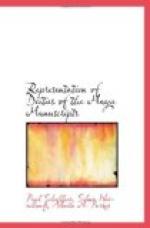The hieroglyph belonging to this deity likewise displays the Chicchan-sign as its distinguishing mark. Furthermore several variants occur. The Chicchan-sign has sometimes the form of Fig. 37 and again that of Fig. 38. The prefix likewise differs very much, having sometimes the form of Fig. 37, and again that of Fig. 38 or of Figs. 39 and 40. Thus there are, in all, four different forms of the prefix. It is to be assumed that all these hieroglyphs have the same meaning, notwithstanding their variations. Taking into consideration the frequency of the variations of other hieroglyphs of gods and of the hieroglyphs in the Maya manuscripts in general, it is quite improbable from the nature of the case, that a hieroglyph, which displays so great an agreement in its essential and characteristic elements, should denote several different gods. The dissimilarity which Seler thinks he finds between the forms of the Chicchan-sign in Figs. 37 and 38 and which leads him to assume that Fig. 37 is not a Chicchan-sign at all, but that it denotes another face ornament, cannot be satisfactorily proved, and must be regarded as an arbitrary assumption. The Chicchan-mark in the sign of the day Chicchan also differs very much from that on the bodies of the serpents pictured in the manuuscripts, so that variations of this kind by no means make it necessary to assume that the hieroglyphs actually denote different things. Observe, for example, the different Chicchan-spots on the serpent’s body in Tro. 27a. The crenelated, black border of the Chicchan-spot in Fig. 38 passes in rapid cursive drawing almost of itself into the scallops of Fig. 37, a transition to which there are distinct tendencies on the serpent’s body in Tro. 27a. Nor does the fact, that under H’s hieroglyph different personages are very often pictured, whom we cannot positively identify, compel the assumption that we have here not one, but two or more mythical figures, for the same is true of other hieroglyphs of gods. There are many places in the manuscripts where the text contains a definite well-known hieroglyph of a god, while the accompanying picture represents some other deity or some other figure not definitely characterized, perhaps merely a human form (priest, warrior, woman and the like). Thus in Dr. 4a we see H’s hieroglyph in the text, but the picture is the figure of god P while in other places we miss the characteristic Chicchan-spot on the figure represented, for example Dr. 4c, 6a, 7b, 7c, 14a, 21c. In the Madrid manuscript, it is true, H’s hieroglyph also occurs often enough, but not in a single instance is a deity represented displaying the Chicchan-spot. This fact is, I think, to be explained by the coarser style of the drawing, which does not admit of representing such fine details as in the Dresden manuscript. In the Paris manuscript H’s hieroglyph occurs but once (p. 8, bottom).




